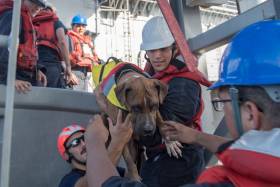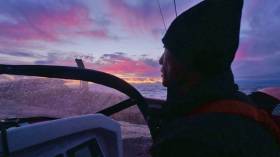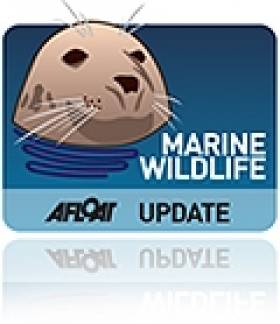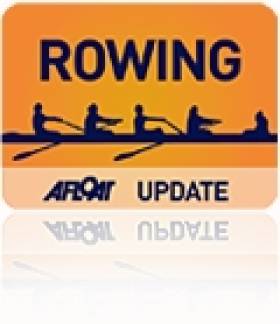Displaying items by tag: Pacific
A Pacific expedition has discovered over 30 “potentially new” marine species ranging from sea cucumbers to starfish.
The new species were collected by a team from Britain’s Natural History Museum, using a remotely operated vehicle (ROV) in the abyssal plans of the Clarion-Clipperton zone of the central Pacific – an area rich in minerals and the focus of deep sea mining.
Lead author of the study, Dr Guadalupe Bribiesca-Contreras, said the megafauna specimens had previously only been studied from seabed images.
 Peniagone vitrea is one of the oldest deep sea species known, being discovered by the Challenger expedition in the 1870s. Image © DeepCCZ expedition, Gordon & Betty Moore Foundation & NOAA.
Peniagone vitrea is one of the oldest deep sea species known, being discovered by the Challenger expedition in the 1870s. Image © DeepCCZ expedition, Gordon & Betty Moore Foundation & NOAA.
“Without the specimens and the DNA data they hold, we cannot properly identify the animals and understand how many different species there are,” he said.
Of some 55 specimens recovered, 48 were different species. Dr Adrian Glover of the Natural History Museum’s Deep Sea Research Group said that it was known that “small millimetre-sized animals called macrofauna are extremely biodiverse in the abyss”.
“However, we have never really had much information on the larger animals we call megafauna, as so few samples have been collected,” Dr Glover said.
“ This study is the first to suggest that diversity may be very high in these groups as well,” he said.
The researchers say the findings add further evidence that the majority of deep sea life is yet to be discovered.
 This unidentified Zoroaster starfish is one of the species that may be new to science. Image © DeepCCZ expedition, Gordon & Betty Moore Foundation & NOAA.
This unidentified Zoroaster starfish is one of the species that may be new to science. Image © DeepCCZ expedition, Gordon & Betty Moore Foundation & NOAA.
The Clarion-Clipperton Zone covers over five million square kilometres in the Pacific Ocean, lying between Hawaii and Mexico, and is around 5,500 metres at its deepest – nearly as deep as Mount Kilimanjaro is high.
Large portions of its flat abyssal plans are covered in polymetallic nodules – mineral lumps the size of potatoes which are rich in key metals such as cobalt, nickel, manganese and copper. It has been estimated that there is more cobalt and nickel in polymetallic nodules than can be found on land.
 Four specimens of Psychronaetes sea cucumber were collected, and are thought to represent a new species. Image © DeepCCZ expedition, Gordon & Betty Moore Foundation & NOAA.
Four specimens of Psychronaetes sea cucumber were collected, and are thought to represent a new species. Image © DeepCCZ expedition, Gordon & Betty Moore Foundation & NOAA.
These minerals are required for wind turbines, electric cars and other net-zero energy technologies, so there is a push for seabed mining to pave the way for a green revolution.
However, opponents worry that seabed mining could cause irreparable damage to seafloor ecosystems.
The CCZ is a focus of scientific research to evaluate the impacts of seabed mining on this environment, and the study examined three of the protected Areas of Particular Environmental Interest.
The study was funded with grants from the Gordon and Betty Moore Foundation, the National Oceanic and Atmospheric Administration, and the leadership of Prof Emeritus Craig Smith of the University of Hawaii.'
The paper in Zookeys is available here
Doubts Emerge Over Rescued Pacific Sailors’ Story
#Offshore - Doubts have been cast over the predicament of two female sailors rescued in the Pacific last week after investigators called into question some parts of their story.
As previously reported on Afloat.ie, Jennifer Appel and Tasha Fuiaba were picked up by the US Navy last Wednesday (25 October) some 900 miles from Japan, thousands of miles off course from their reputed voyage from Hawaii to Tahiti.
However, contrary to the tale that the pair had been adrift with no land in sight since the end of May, CBS News reports that their boat the Sea Nymph had numerous opportunities to make landfall, from turning back to Hawaii to seeking help en route at Christmas Island and Kiribati’s largest island.
What’s more, the sailors had even confirmed by radio to the US Coast Guard that they were not in distress at a point after they reportedly lost the use of their engines and damaged their sails in stormy weather — though meteorologists have no record of storm activity in the region where they claim to have been.
The US Coast Guard also confirmed earlier this week that the women had a working EPRIB on board but had chosen not to activate it, despite their claims of being close to giving up on finding help.
CBS News has much more on the story HERE.
Women & Dogs Rescued From Pacific After Five-Month Yacht Ordeal
#Offshore - Two women have been rescued in the Pacific Ocean after a dream voyage from Hawaii to Tahiti turned into a months-long nightmare, as RTÉ News reports.
Jennifer Appel and Tasha Fuiaba set out five months ago on their small sailing yacht headed south towards French Polynesia, a distance of some 3,200km.
Shortly into their voyage, they lost the use of their engine and decided to carry on by sail towards landfall.
With no land in sight by the end of July, the pair started to issue distress calls — but being too far from any other vessels or stations, those calls went unanswered.
It wasn’t until this past Tuesday (24 October) that a Taiwanese fishing boat notified US authorities that it had found Appel and Fuiaba, and their two dogs, in the Philippine Sea between Japan and Guam — thousands of nautical miles off course.
The US Navy subsequently posted a video of their rescue of the women, who survived their ordeal thanks to bringing with them more a year’s supply of food along with water purifyers.
RTÉ News has more on the story HERE.
Search For Missing Chinese Sailor Guo Chuan Called Off
#GuoChuan - Record-setting Chinese offshore skipper Guo Chuan has gone missing on a solo crossing of the Pacific, according to BBC News.
Guo Chuan had connections with Ireland as a crew-member on Irish-Chinese backed Green Dragon and became the first-ever Asian participant, with skipper Ian Walker in the 2008/09 Volvo Ocean Race
US Coast Guard teams now suspended their search in the waters off Hawaii where Guo’s boat was spotted abandoned shortly after his support team lost contact on Tuesday morning Irish time.
Guo’s yacht, the Qingdao China, was reportedly seen from a search plane with its main sail snapped off some 1,000km off Oahu.
Rescuers boarding the boat later found his lifejacket among his belongings.
The experienced sailor had been attempting to break the speed record for a solo Pacific crossing, which currently stands at 21 days.
A year ago, Irish offshore sailor Jarlath Cunnane was among the first to congratulate Guo on a record transit of the North East Passage with a team on board his 26.5m trimaran.
China’s best-known sailor previously sailed around the world in a 12m yacht in 2013.
* The USCG has suspended the search:
UPDATE: COAST GUARD SUSPENDS SEARCH FOR MISSING CHINESE TRANS-PACIFIC MARINER
HONOLULU — The Coast Guard suspended the active search Wednesday evening for a Chinese mariner who was unreported while sailing his 97-foot super trimaran across the Pacific.
Guo Chuan, 50, remains missing.
"Mr. Chuan was a professional mariner with a deep passion for sailing," said Capt. Robert Hendrickson, chief of response, Coast Guard 14th District. "Our thanks to our Navy partners who helped us search for this vessel in a timely manner so far from shore in an attempt to locate Mr. Chuan. Our deepest condolences go out not only to his family and friends but also to his racing team and the sailing community."
Coast Guard HC-130 Hercules crews conducted six search patterns in the vicinity of the Quindao China and its charted course following notification of the situation Tuesday and into Wednesday. The USS Makin Island deployed an MH-60 Seahawk helicopter Wednesday once they were in range to attempt contact with Chuan. Their hails over the radio went unanswered and weather conditions prevented safe deployment of a rescue swimmer to the vessel. They followed up by deploying a rigid-hulled inflatable boat and crew to conduct a boarding of the trimaran Wednesday afternoon. The boatcrew confirmed Chuan was not on the vessel although his life jacket remains aboard.
Weather on scene was reportedly 23 mph winds, seas to 5-feet with good visibility and scattered clouds.
On-scene assets searched a total area of more than 4,600 square miles over the two-day period.
Involved in the search were:
- HC-130 Hercules airplane crews from Coast Guard Air Station Barbers Point
- USS Makin Island (LHD 8) homeported out of San Diego
- Navy MH-60 Seahawk helicopter crew attached to the USS Makin Island
The Quindao China remains adrift, the mainsail has been doused and the vessel has been marked. A broadcast notice to mariners alerting vessel crews in the area to the potential hazard to navigation has been issued. Chuan’s racing team is making arrangements to recover the vessel.
Tuesday morning, watchstanders at the Coast Guard Joint Rescue Coordination Center Honolulu received notification from Maritime Rescue Coordination Center China personnel that the vessel Qingdao China, with one person aboard, had not been heard from for 24 hours prompting the response.
The Makin Island is an amphibious assault ship attached to the Makin Island Amphibious Ready Group and 11th Marine Expeditionary Unit that departed Naval Station San Diego for a scheduled deployment, Oct. 14, to provide maritime security operations, crisis response capability, theater security cooperation and forward naval presence in the Pacific.
'False' Flags In The 'Wild West' Of Pacific Tuna Fishing
#Fishing - Overfishing. Pollution. Exploitation. Carelessness. The story of one American fishing captain's experiences onboard a nominally US-flagged boat in the Pacific tuna fleet is an alarming one.
Writing for Matter, science writer Kalee Thompson reports on Doug Pine's near-mutiny on board the tuna boat Majestic Blue, the culmination of a series of disturbing events themselves the end result of dodgy deals involving a Korean conglomerate with a reputation for illegal fishing, and congressional lobbyists pushing for ever more lax regulations in order to preserve a paper presence in the tuna business.
Efforts to save America's dwindling tuna fishing industry in the wake of the dolphin catch scandals of decades past found a solution in outsourcing – and have produced a farcical situation where American 'captains' preside over what for all practical purposes are foreign boats with foreign crews, with no actual control over what happens at sea.
And that's only the half of it when it comes to the so-called 'distant water tuna fleet', operating amid a kind of lawlessness akin to piracy around the poverty-stricken islands of the Western Pacific, at the expense of marginalised crew and vulnerable marine wildlife alike.
Matter has much more on the story HERE.
Lisburn's Resident 'Sealebrity' Lights Up Social Media
#MarineWildlife - Northern Ireland's Exploris aquarium has put out a call to Lisburn locals to help them track down a notorious resident seal who's become somewhat of a landlubber.
As Lisburn Today reports, Sammy – as the seal's been named on social media – has been a regular fixture in the Laganside town for a number of years, and has recently been spotted as far as seven miles inland.
Various reports have described the unique habits of this 'sealebrity' who's been spotted walking the towpath at Lisburn's civic centre towards Hill Street near the centre of town.
But until now staff at Exploris have been unable to get a hold of Sammy to check on the seal's condition.
“We would very much like to get a closer look at her," they said in a recent appeal. "If you see her please call us!”
Elsewhere, sea lions in California are having a tough time of it due to rising ocean temperatures in the Pacific.
And according to Salon, it's a situation that will only get worse when the effects of human-induced global warming take hold.
Some 1,800 stranded sea lion pups have been recorded on California's beaches in just the first two-and-a-half months of this year, many of them in an emaciated state.
Warming waters hostile to key fish species and micro-organisms have been blamed for this phenomenon, as the sea lions are forced to swim exhausting distances for sustenance.
The flight of fish to more suitable temperatures elsewhere is also having an impact on fishing communities up and down America's western seaboard.
But while the cause of the current 'hot spot' may be "a fluke of climate variability", for some experts it points to future trends in the world's largest ocean. Salon has more on the story HERE.
Irishman Prepares For Pacific Rowing Race
#OceanRowing: Irishman Philip Cavanagh is set to compete in the Great Pacific rowing race from Monterey in California to Honolulu in Hawaii next summer. Cavanagh is putting together a four-person team, which will be called Battleborn. Barry Hayes from Wales and Englishman Howard Wagstaff are already signed up. None of the three had been rowers prior to committing to this project.
The race, which the organisers hope to run every two years, covers approximately 2,100 nautical miles (2,400 miles; 3,890 kilometres) and there will be trophies for the fastest four, pair and single to complete the journey. Nineteen crews (seven fours, six singles and six pairs) intend to compete.
Tripartite Naval Visitors for Dublin Port
Naval vessels from France, Canada and Belgium are due to make calls to Dublin Port over the weekend, writes Jehan Ashmore.
The first visitor to dock tomorrow will be the Latouche-Tréville (D646) a F70 type anti-submarine frigate of the French Marine Nationale. She is one of seven F70 ASM class anti-submarine frigates and is capable of carrying two 2 Lynx helicopters. In June 2010 the frigate visited London where the 1984 built 3,550 tonnes vessel moored alongside the WW II cruiser, HMS Belfast.
Also due to arrive tomorrow is the Canadian Navy's HMCS St. John's which too is to berth at Ocean Pier. HMCS St. John's (340) is the eleventh 'Halifax' class frigate, measuring some 4,770 tonnes. The multi-role patrol frigate was commissioned in 1996 in St. John's, Newfoundland and is designed to perform three distinct functions: anti-submarine warfare, anti-air warfare and anti-surface warfare.
On Sunday the third international naval visitor to Dublin Port will be the Belgium Navy's Léopold I (F930). This frigate is based in the Quartier Naval Base in Zeebrugge and in 1997 she was commissioned into service in a ceremony by Belgium's Queen Fabiola.
The 2,800 tonnes frigate is capable of taking two helicopters and the vessel can cruise at 21 knots using two diesel engines or is capable of reaching a top speed of 30 knots based from gas turbine power-plants. Léopold I has participated in NATO's Response Force (NRF). For a detailed visual discription of equipment click this link here
Cruise from Kinvara to Tahiti Wins Sailor of the Month Award
Recognised by the senior offshore sailing organisation, the Irish Cruising Club, with the award of the historic Faulkner Cup, the Quinlan's achievement is further enhanced by the fact that, in their determination to acquire a boat suitable for long distance voyaging, they built their steel-constructed 40ft cutter Pylades themselves, launching in 1997.

They have brought a lively and enquiring eye to the complex project, something which reflects Fergus's qualifications as an architect. As he has drily observed himself, there isn't a lot of work around for architects in Ireland at the moment, so everything clicked with the boat sea-tested and ready to go off on this sail of a lifetime.
Having left Kinvara in June 2009, their longterm plan is a global circumnavigation, returning to Galway Bay in August 2012. Quite what Ireland will be like by then is anybody's guess. But as it is, the crew of Pylades have enough to be getting on with in dealing with the vagaries of the open ocean, and the volatile political situation in some of the areas where ocean voyagers go. For armchair sailors at home, their thoughtful and entertaining reports on their experiences make them worthy "Sailors of the Month".



































































